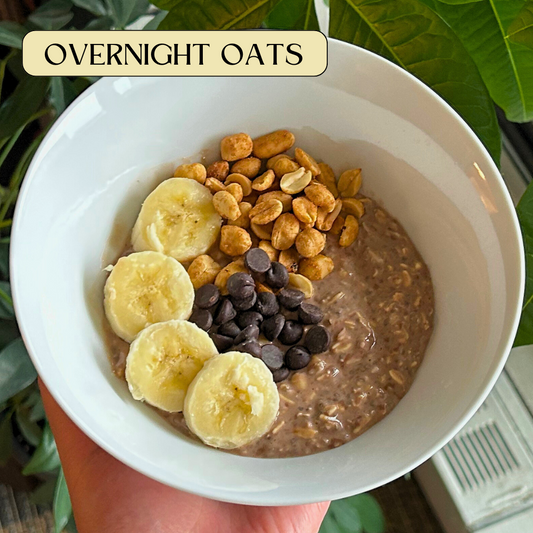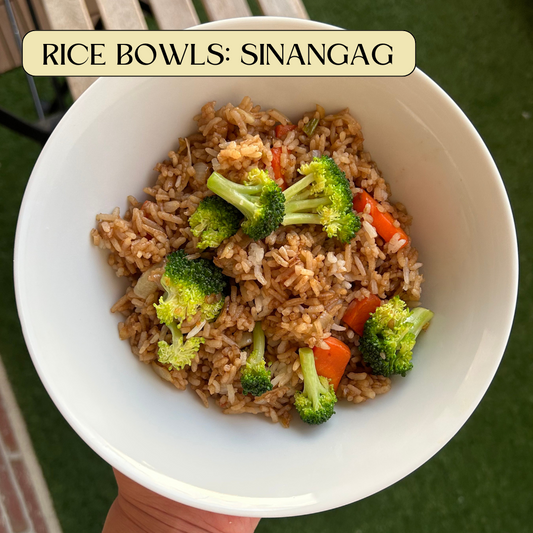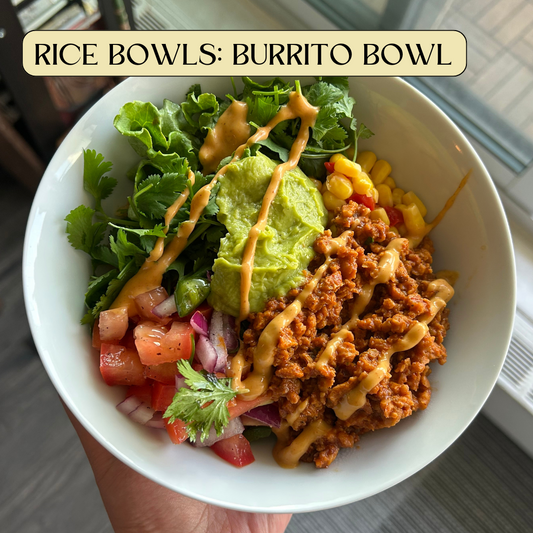| Table of Contents |
| Some Background: What is Bibimbap? |
| Recipe for Bibimbap |
Rice is a stable in my home. Always has been. My mom would always say: "A meal isn't a meal without rice". On days when I come home late, exhausted, and just want to eat something before bed, I know I can easily make myself a bowl of rice and eggs and I'll be perfectly content.
All this to say... I love rice.
Rice is such a versatile base. It's good on it's own and great when it's been dolled up. Serve it with some soy sauce, cook it in broth instead of water, use the left-overs for fried rice - the possibilities are endless.
Something I've been really loving lately are rice bowls - bowls with rice as a base and a ton of ingredients on top. These meals are pretty easy to make, they just require a ton of steps. And because rice bowls require so much prep, I usually make extra for lunches/dinners for the next couple of days, since making 1-2 servings takes the same amount of time as making 5-6 servings.

Rice Bowls: Bibimbap, Burrito Bowl, and Sinangag
Rice bowls usually include the following:
- Rice: as the base
- Toppings: from veggies to salads
- Protein: from chicken, to fish, to tofu - whatever your heart desires
- Sauce: optional, but always fun to include
In this blog miniseries, I'll be going over 3 different rice bowl recipes: Bibimbap, a Burrito Bowl, and a Filipino-style rice bowl. Originally, I wanted to fit all three recipes into one post but I've found so much background on these dishes, this blog will be a three-parter. For the first of three parts, we'll be going over Bibimbap.
Skip to the Bibimbap recipe here.
To check out another delicious rice bowl, see my recipe for a Burrito Bowl!
What is Bibimbap?
I love Korean food, and Bibimbap (비빔밥) is definitely one of my favourite Korean dishes. The name of the dish is a derivative of both "bibim" (비빔), which roughly means to mix, and "bap" (밥), which is the Korean term for cooked rice.
So what is bibimbap?

Dolsot Bibimbap served with other Korean sides
Bibimbap is composed of an assortment of vegetables on a bed of rice, a seasoned protein, with the main condiment being Gochujang sauce, and almost always: a raw or fried egg on top.
This dish hits all the right notes, with balanced flavours of sweet, spice, salty, sour and bitter. In fact, hansik (한식) (traditional Korean cuisine) is a reflection of obangsaek (오방색). Obangsaek derives from the Chinese philosophy of Yin and Yang, wherein which there is harmony in accordance to the five elements.
Obangsaek hold significance in five colours: red, blue, yellow, white, and black.
- Red: represents fire, south, and summer.
- Green/blue (green is is sometimes considered another shade of blue so the colours are grouped together): represents wood, east and spring.
- White: represents metal, west and autumn.
- Black: represents water, north, and winter.
- Yellow: represents earth, and is at the centre of the cardinal directions
These colours are prevalent throughout Korean culture: from clothing, to art, symbolism, and food. According to an article by Korea's Ministry of Culture, Sports and Tourism, when applying these colours to food, the colours are as followed:
- Red foods: considered beneficial for improving blood circulation. An example is red peppers.
- Green/blue foods: considered beneficial for strengthening the liver and intestines. Examples include cucumber and green onions.
- White foods: related to lung function. Examples of white foods include rice, onions, garlic, and lotus root.
- Black foods: believed to protect the kidney and bladder. Examples include black rice, black beans and sesame.
- Yellow foods: believed to trigger appetite, and includes squash, sweet potatoes and soybeans.

The separate components to this dish may take some time to prepare, but once everything's gathered, assembling will be fun and easy.
Recipe: What is in Bibimbap?
Here's what you can find in bibimbap and my simplified recipe for the well-loved, Korean rice dish.
Ingredients
Rice
Rice is the base of bibimbap, although you can use alternatives such as riced cauliflower or Shirataki rice. Short grain rice is typically used, but I use jasmine because it's what I usually have in my kitchen. For one serving, I'd use about half a cup of rice as the base.

Vegetables
An assortment of vegetables, both raw and cooked.
- Mung bean sprouts
- I like to use about a quarter cup for 1-2 servings
- I also like to sauté mung beans with onions and soy sauce
- When my local grocery store runs out of mung bean sprouts or when I want to use a raw ingredient, a good alternative I like to use is broccoli sprouts or alfalfa sprouts.
- Edamame
- A Japanese, not Korean, side so not a typical ingredient in bibimbap. But I like adding edamame because it complements the dish well and is a good additional source of protein, fibre, and antioxidants.
- Carrots
- Cucumber
- Green onions

The amount of veggies you use depends on preference. You can use your veggie assortment as toppings or have as much as your rice base. Prepare your veggies by washing then julienning (or use a potato peeler to save time). I like to mainly use raw veggies because it's less work haha. Sprouts, edamame, carrots, cucumbers, and green onions are my essentials when making this dish. Add or substitute with other vegetables such as zucchini, mushrooms, spinach, or mixed greens.
Protein
Bibimbap is typically served with thinly sliced beef, although alternatives can include chicken, pork, shrimp, tofu, plant-based ground... whatever you want and have! When I make bibimbap for my loved ones, I like to serve it with steak (usually a flank or bottom sirloin); when I make it for myself, I like to use either the Yves Veggie Ground Round, or the Beyond Beef.
I like to keep the seasoning for the protein simple as there's already a main sauce for the bibimbap. Salt and pepper will do, but I like to prepare a complementary marinade for the protein (usually a toned down version of a bulgogi marinade). Ideally, you'd want to have your protein sitting in the marinate overnight, but when you're in a pinch (or decide last minute you want bibimbap), a 20-minute marinate will do.

Sauce
To make a simple, no-nonsense bibimbap, the only sauce I'll use with my rice is a combo of gochujang and sesame oil. Or when I'm feeling a lil crazy, I like to use the Samyang Buldak Sauce or the Samyang Carbonara Buldak Sauce.
Otherwise, there are 2 sauces I like to prepare for Bibimbap. One is a simple marinate for the protein, the other is served on the bibimbap itself.
For the marinate (for about 1-2 portions or protein):
- ¼ cup of soy sauce
- 1 garlic clove, finely minced
- 2 tablespoons of sesame oil
- 1 tsp rice vinegar
- 1 tsp of onion powder
- 1 tsp of ground ginger
- 1 tsp of honey
- ground black pepper
Mix all the ingredients together in a bowl and use for your protein of choice.
I like to keep about a teaspoon of the marinate off to the side to drizzle on the protein after it's been cooked.

Illustrations for rice vinegar, honey, black pepper, soy sauce, gochujang, onion powder, ginger powder, sesame oil, garlic, and sugar.
For the Bibimbap Sauce (for about 1-2 servings)
- 2 tblsp of gochujang
- 1 tblsp of sesame oil
- 1 tblsp of soy sauce
- 1 tsp dehydrated and minced garlic
- ½ tsp sugar
Mix all the ingredients together in a bowl and set aside for your rice once your bowl is ready to be assembled.
Other Toppings
In addition to a runny fried egg, the following toppings are specials that I love to add to my Bibimbap that ties everything together. When I know I'm making bibimbap, I'll go out of my way to buy these ingredients - if I don't have them at home already.
- Kimchi
- Roasted seaweed
- Wakame salad
- Roasted sesame seeds

Pictured: kimchi, roasted seaweed, wakame salad, fried egg
Directions
1. Get all your ingredients ready: this includes making your rice, cooking your protein, preparing your veggies and sauce, and frying an egg.
- Rice: My first step in preparing bibimbap is getting the rice ready. I like to cook one cup of rice to make 1-2 servings of bibimbap. My rice cooker usually takes 20 minutes to fully cook one cup of rice, so making the rice is usually my first step when preparing bibimbap.
- Protein: Cooking the protein usually takes just as much time, if not more, than making the rice, so this is usually my second step when making bibimbap. If you're marinating your protein, make sure to start marinating at least 20 minutes before you plan to cook. Otherwise, heat a well-oiled pan on med-high. Once your pan is heated, slowly place in your protein. Cook your protein thoroughly. Once it's done, place on a separate dish and let it rest while you prepare your other ingredients. If the protein was made with a marinade, I like to top off the protein with some of the marinade as it rests.

- Veggies: wash and julienne your veggies. This step is something I typically do as the rice and protein cook. Can be considered the "easiest" of the steps, but washing and julienning can take some time, especially if you're adding a lot of veggies to your bibimbap. If I know I'm make bibimbap the night before, I'll try to prepare the raw veggies the night before. If I'm using cooked veggies in my bibimbap, it'll usually be veggies that cook quickly. Keep your prepared veggies in a separate plate to the side until your ready to assemble your bibimbap.
- Sauce: in a small bowl, mix the ingredients for your bibimbap sauce. Set aside until you're ready to assemble your dish.
- The fried egg: in a hot pan, quickly fry up an egg. Some variations of bibimbap include a raw egg yolk, but a runny fried egg is also delicious. Set your egg off to the side until it's ready to be served.
2. Assemble your bibimbap.
- Place about half a cup of cooked rice into your bowl. Bibimbap is usually served in a metal/mixing bowl, or in a dolsot (Korean stoneware made from fine clay/stone) for dolsot bibimbap (돌솥 비빔밥).
- Add some of the bibimbap sauce on top of the rice.
- Layer your veggies, protein, and other toppings on your rice.
- Sometimes, if the bowl's too filled to add in more toppings, I'll serve the protein off to the side on another dish.
- If you'd like, add another dash of your bibimbap sauce on top
- Top off your bibimbap with a fried egg.
3. Serve, mix and enjoy!

Bibimbap topped with broccoli sprouts, carrots, roasted seaweed, edamame, and fried eggs, served with steak
In the next blog, we'll go over the recipes for a Burrito Bowl and Sinangang :)





